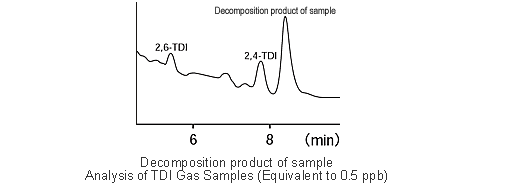Measurement of Toluene Diisocyanate (TDI) in the Working Environment
Under a 1995 partial revision of the Japanese Working Environment Assessment Standards and Working Environment Measurement Standards, high-performance liquid chromatography was prescribed as an analysis method for ethyleneimine, 3,3'-dichloro-4,4'-diaminodiphenylmethane, and toluene diisocyanate (TDI), as an addition to the methods at that time. Of these substances, TDI is commonly used as an ingredient in polyurethane foam, a polymerization cross-linking agent, foaming agent, coating, and adhesive. TDI is highly toxic to humans and acute poisoning may lead to pneumonia or bronchitis, and in severe cases may result in death due to cardiac debility. The TDI concentration standard in the working environment has been revised to 5 ppb, with measurements required to 10% of this concentration (0.5 ppb).
Reference
K. Nakaaki, S. Koike, Y. Takada: Journal of Science of Labour 63 (1), 1-13, 1987

High-Performance Liquid Chromatograph
This separation/analysis instrument is widely used for the quantitative analysis of chemical substances. It is used with a combination of detector and mobile phase that suits the analysis target components. It achieves higher sensitivity than conventional absorption spectrophotometry methods for TDI and permits the separation and determination of isomers.


